1902 Search Results for video of the week
November 15, 2018
by Carole Zangari -
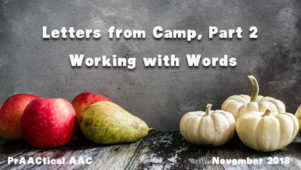
The weather is nippy here in Boston where 12,000+ professionals are gathered for the annual ASHA Convention, and the blustery wind makes us think back longingly to the warmer days of summer. Today. Ohio-based SLP Tina Moreno helps us do just that as she returns to share more information on the reading and writing activities that AAC learners in Camp ALEC experienced. In today’s post, she shares some of the details about Working with Words. If you missed it the first time, you can visit Tina’s earlier post here. Many thank to AAC mom and SLP Tina Moreno for giving us a peek into the wonderful instruction provided to these AAC learners! ::::::::::::::::::::::::::::::::::::::::::::::::::::::::::::::::::::::::::::::::::::::::::::::::::::::::::: Working with Words at Camp ALEC At Camp ALEC in August, our literacy counselors planned fun, motivating activities that helped our campers learn to read and write new words. In another setting, we might refer to these... [Read More...]
November 13, 2018
by Carole Zangari -
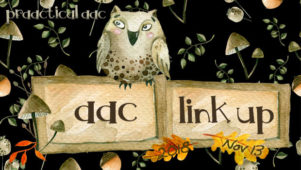
Happy Tuesday, AAC friends! Once a week, we invite you to share your own AAC-related content, product news, or anything else that you’d like others in the AAC community to know about. It may be a recent post you’ve written, a slide deck from your AAC presentation, a handout, video, or meme that you’ve posted online, an AAC product you’ve created, an announcement for an AAC camp or conference, or any other prAACtical content you developed and want to share with the AAC community. To post your own link, scroll all the way down to the bottom of this post and complete the form. Enter the URL and the name/title in the boxes provided below. If you are on a mobile device, click over to the full website version to do this. The AAC Link Up is moderated to keep us from being spammed, so it may take a little while... [Read More...]
November 12, 2018
by Carole Zangari -
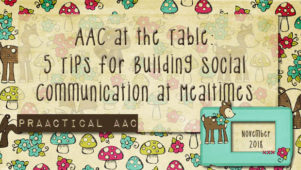
Think back on some of the meals that you’ve shared with others recently. What did people talk about? In most cases, there’s a lot more that ‘Pass the peas,’ ‘What’s for dessert?’, and ‘Can I go now?’ Mealtimes are social experiences in many cultures and it can take some work to ensure that our AAC learners can take part. Here are some ideas for supporting the development of social communication during shared meals. Build a routine that includes social communication: AAC learning takes time and lots of prAACtice. We can support the march to AAC proficiency by incorporating specific kinds of social exchanges into our mealtimes so that AAC learners know what the expect and have practice opportunities for this skill set at mealtime. Some examples: Sharing Time (i.e.., everyone shares something that happened to them that was funny/interesting/memorable), Question of the Day (e.g., “What’s your favorite __?” “Where’s the... [Read More...]
November 8, 2018
by Carole Zangari -
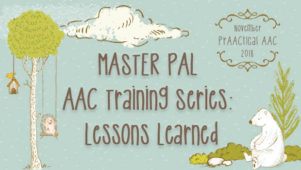
Thanks to all who reached out to express appreciation for Tabi Jones-Wohleber’s training resources in the MASTER PAL series. Many of you have already used the slides, video links, handouts, and discussion points that were shared over the past few months, and others have plans to do so. In this final post, Tabi shares some of the ‘lessons learned’ in creating and utilizing these materials. If you’re new to the series, you can check out each of the 11 modules here. ::::::::::::::::::::::::::::::::::::::::::::::::::::::::::::::::::::::::::::::::::::::::::::::::::::::::::::::::::::::::::::::::::; Over the last 11 weeks, facilitation strategies for communication partners have been shared through the Model as a MASTER PAL series. Model as a MASTER PAL is a framework for supporting communication partners of those who use AAC that evolved in response to the need go beyond the imperative and always present conversations of “use core words” and “model AAC”. It started as a list of ideas to... [Read More...]
November 6, 2018
by Carole Zangari -
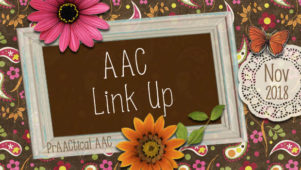
Happy Tuesday, AAC friends! Once a week, we invite you to share your own AAC-related content, product news, or anything else that you’d like others in the AAC community to know about. It may be a recent post you’ve written, a slide deck from your AAC presentation, a handout, video, or meme that you’ve posted online, an AAC product you’ve created, an announcement for an AAC camp or conference, or any other prAACtical content you developed and want to share with the AAC community. To post your own link, scroll all the way down to the bottom of this post and complete the form. Enter the URL and the name/title in the boxes provided below. If you are on a mobile device, click over to the full website version to do this. The AAC Link Up is moderated to keep us from being spammed, so it may take a little while... [Read More...]
November 1, 2018
by Carole Zangari -
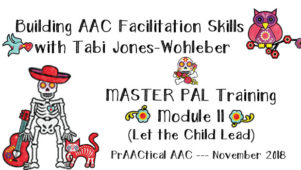
Today, Tabi Jones-Wohleber shares the last module in the MASTER PAL training series, which provides tips and strategies for working with children who don’t yet demonstrate joint attention. This module should take 30-40 minutes to present. Join us next week as we do a final wrap-up with suggestions on using this training series in your AAC work. ::::::::::::::::::::::::::::::::::::::::::::::::::::::::::::::::::::::::::::::::::::::::::::::::::::::::::::::: Model as a MASTER PAL Module 11: Let the Child Lead Facilitator Guidelines It can be really difficult to get communication started with a child who does not demonstrate joint attention. This module explores tips and strategies for traveling with a child on their journey from preoccupation with seeking sensory input/inattention to learning, engaging, and communicating. Because learning emerges from meaningful social emotional experiences, letting the child lead can go a long way toward being invited into their world. Then learning can happen! Here are some things you will need for this... [Read More...]
October 30, 2018
by Carole Zangari -
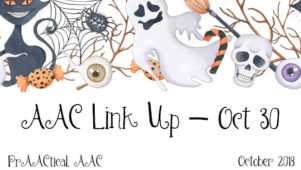
Happy Tuesday, AAC friends! Once a week, we invite you to share your own AAC-related content, product news, or anything else that you’d like others in the AAC community to know about. It may be a recent post you’ve written, a slide deck from your AAC presentation, a handout, video, or meme that you’ve posted online, an AAC product you’ve created, an announcement for an AAC camp or conference, or any other prAACtical content you developed and want to share with the AAC community. To post your own link, scroll all the way down to the bottom of this post and complete the form. Enter the URL and the name/title in the boxes provided below. If you are on a mobile device, click over to the full website version to do this. The AAC Link Up is moderated to keep us from being spammed, so it may take a little while... [Read More...]
October 23, 2018
by Carole Zangari -
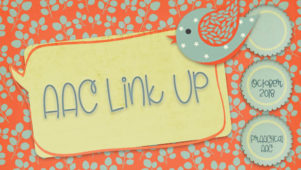
Happy Tuesday, AAC friends! Once a week, we invite you to share your own AAC-related content, product news, or anything else that you’d like others in the AAC community to know about. It may be a recent post you’ve written, a slide deck from your AAC presentation, a handout, video, or meme that you’ve posted online, an AAC product you’ve created, an announcement for an AAC camp or conference, or any other prAACtical content you developed and want to share with the AAC community. To post your own link, scroll all the way down to the bottom of this post and complete the form. Enter the URL and the name/title in the boxes provided below. If you are on a mobile device, click over to the full website version to do this. The AAC Link Up is moderated to keep us from being spammed, so it may take a little while... [Read More...]
October 22, 2018
by Carole Zangari -
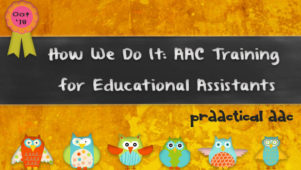
We’ve been focusing on training communication partners recently and today we’re focusing specifically on paraprofessionals/educational assistants. Our guest post is authored by SLPs Corinna Duffitt, M.Sc., RSLP (practicing for 21 years, 14 years in AAC) and Jennifer Wiegert, M.A., CCC-RSLP (practicing for 21 years, focusing on AAC for the past 6 years). They are colleagues on an AAC team with 4 other SLPs in a large school district in Surrey, BC, Canada. Their school district consists of 101 elementary schools and 20 secondary schools. Corinna and Jennifer are both passionate about giving children a voice and letting that voice uncovers their potential. They recently joined their private practice endeavours, outside of their public school positions, to form Chickadee AAC Communication Services. You can find them on Instagram (@chickadeeaacslps or #chickadeeaac), check in on their website, and/or follow them on Facebook. :::::::::::::::::::::::::::::::::::::::::::::::::::::::::::::::::::::::::::::::::::::::::::::::::::::::: AAC Training for Educational Assistants Some of the challenges we encountered... [Read More...]
October 16, 2018
by Carole Zangari -
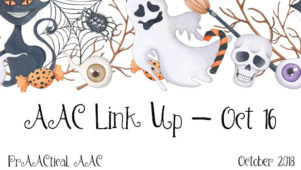
Happy Tuesday, AAC friends! Once a week, we invite you to share your own AAC-related content, product news, or anything else that you’d like others in the AAC community to know about. It may be a recent post you’ve written, a slide deck from your AAC presentation, a handout, video, or meme that you’ve posted online, an AAC product you’ve created, an announcement for an AAC camp or conference, or any other prAACtical content you developed and want to share with the AAC community. To post your own link, scroll all the way down to the bottom of this post and complete the form. Enter the URL and the name/title in the boxes provided below. If you are on a mobile device, click over to the full website version to do this. The AAC Link Up is moderated to keep us from being spammed, so it may take a little while... [Read More...]









